 Airplane- Orville
and Wilbur Wright, were two American brothers, investors, and aviation
pioneers who credited with inventing and building the world's first
successful airplane. The Wright brothers' airplane was the first machine
that allowed people to fly. Many of us have traveled by airplane to
places that would have taken much longer by any other means of
trasportation. An airplane by definition is an aircraft that has a fixed
wing and is powered by propellers or jets. This was a great invention
to travel far distances.
Airplane- Orville
and Wilbur Wright, were two American brothers, investors, and aviation
pioneers who credited with inventing and building the world's first
successful airplane. The Wright brothers' airplane was the first machine
that allowed people to fly. Many of us have traveled by airplane to
places that would have taken much longer by any other means of
trasportation. An airplane by definition is an aircraft that has a fixed
wing and is powered by propellers or jets. This was a great invention
to travel far distances.
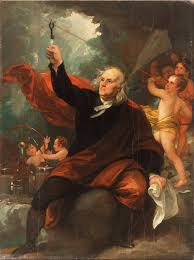
Benjamin Franklin- Benjamin
Franklin was born on January 17, 1706 he was a leading author, printer,
political theorist, politician, postmaster, scientist, musician,
investor and etc. Benjamin invented many things using science, but one
thing he is known for is proving lightning is a source of electricity.
On a stormy night he raised his kite with a key tied near his hand. He
could feel the electric shock go through his body. Ben had finally
proven and understood lightning/electricity. Many people were excited,
and he was supported all around the world. This made the people have a
different perspective of electricity.
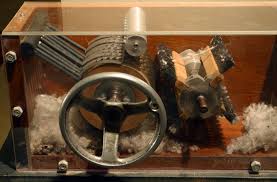
Cotton Gin- Eli
Whitney was an American inventor best known for inventing the cotton
gin. This was one of the key inventions of the Industrial Revolution and
shaped the economy of the world. The machine separated cotton fibers
from the seeds. Before, this work was done by hand. When done by hand it
was a time cussoming job. This was a great technology that made it
easier to pick the seeds and produce goods faster.

Driver less Cars- In
February 2013 Nevada, Florida, and California all passed laws allowing
self-driving cars on their roads. Internet giant Google has been
extensively testing its autonomous car and has driven more than 300,00
miles without incident. To accomplish this goal there is an intense
amount of science, math, and technology. There are many benefits in
having a driver less car; Reduction in the need for traffic police and
vehicle insurance, fewer traffic collisions, and higher speed limit for
autonomous cars.
 Edwin Hubble-In
the late 1920s our understanding of the universe changed dramatically
following the finding by this scientist that what people thought were
nebulous clouds were actually entire galaxies. He also figured out that a
galaxy increases with its distance from the earth, implying the
universe is expanding. He used a mix of math and science to figure this
out.
Edwin Hubble-In
the late 1920s our understanding of the universe changed dramatically
following the finding by this scientist that what people thought were
nebulous clouds were actually entire galaxies. He also figured out that a
galaxy increases with its distance from the earth, implying the
universe is expanding. He used a mix of math and science to figure this
out.
 Felix Baumgartner- After
years of false starts and delays, Austrian skydiver Felix Baumgartner
broke the 50-year-old skydiving record when he jumped from a capsule
more than 24 miles above Earth's surface. In doing so he became the
first human to break the sound barrier outside of an aircraft and proved
the effectiveness of the full-body pressure suit, which could one day
help astronauts survive if they have to abort a mission. He used
science, math and technology to complete this goal.
Felix Baumgartner- After
years of false starts and delays, Austrian skydiver Felix Baumgartner
broke the 50-year-old skydiving record when he jumped from a capsule
more than 24 miles above Earth's surface. In doing so he became the
first human to break the sound barrier outside of an aircraft and proved
the effectiveness of the full-body pressure suit, which could one day
help astronauts survive if they have to abort a mission. He used
science, math and technology to complete this goal.
 Galileo-
Galileo was born on February 15, 1564, in Pisa Italy. He was a
mathematics professor who made pioneering observations of nature and
physics. He constructed a telescope and supported the Copernican theory,
which supports a sun-centered solar system. He was considered "The
Father of Modern Science". He loved science and learning about space.
Galileo-
Galileo was born on February 15, 1564, in Pisa Italy. He was a
mathematics professor who made pioneering observations of nature and
physics. He constructed a telescope and supported the Copernican theory,
which supports a sun-centered solar system. He was considered "The
Father of Modern Science". He loved science and learning about space.
 GMO- A Genetically Modified Organism
is an organism whose genetic material has been altered using genetic
engineering techniques. Using Science, math, and technology. Organisms
that have been genetically modified include micro-organisms such as
bacteria and yeast, insects, plants, fish and mammals. Most of the
things we see and eat are GMO's. They use these GMO's to inject animals
to enhance production or food quality traits {faster growing fish, pigs
that digest food more efficiently}. Also to enrich or enhance the
animals interactions with humans.
GMO- A Genetically Modified Organism
is an organism whose genetic material has been altered using genetic
engineering techniques. Using Science, math, and technology. Organisms
that have been genetically modified include micro-organisms such as
bacteria and yeast, insects, plants, fish and mammals. Most of the
things we see and eat are GMO's. They use these GMO's to inject animals
to enhance production or food quality traits {faster growing fish, pigs
that digest food more efficiently}. Also to enrich or enhance the
animals interactions with humans.
 Hot-Air Ballon- Joseph-Michel
and Jacques-Etienne Montgolfier were the inventors of the hot air
ballon. Their balloon carried a sheep, rooster, and duck for eight
minutes. In 1782 they discovered that heated air, when collected inside a
large lightweight paper or fabric bag, caused the bag to rise into the
air. They
filled their ballon with heated air by burning straw and wool under the
opening at the bottom of the bag. The balloon floated for about 8
minutes and landed safely about 2 miles from the launch site. The two
brothers were honoured by the French Academie des Sciences. They
published books on aeronautics and continued their scientific careers.
Hot-Air Ballon- Joseph-Michel
and Jacques-Etienne Montgolfier were the inventors of the hot air
ballon. Their balloon carried a sheep, rooster, and duck for eight
minutes. In 1782 they discovered that heated air, when collected inside a
large lightweight paper or fabric bag, caused the bag to rise into the
air. They
filled their ballon with heated air by burning straw and wool under the
opening at the bottom of the bag. The balloon floated for about 8
minutes and landed safely about 2 miles from the launch site. The two
brothers were honoured by the French Academie des Sciences. They
published books on aeronautics and continued their scientific careers.
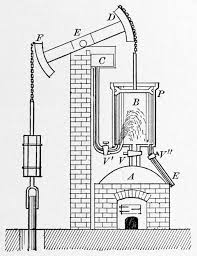 James Watt- James Watt was a Scottish inventor and mechanical engineer who's improvements to the Newcomen steam engine were fundamental to the changes brought by the Industrial Revolution in both his native Great Britain and the rest of the world. The Watt steam engine was the first type of steam engine. Watt
was given a model Newcomen engine to repair. He realised that it was
hopelessly inefficient and began to work to improve the design. Soon he
created the steam engine. This lead to the steam engine boat, and steam
engine train, etc.
James Watt- James Watt was a Scottish inventor and mechanical engineer who's improvements to the Newcomen steam engine were fundamental to the changes brought by the Industrial Revolution in both his native Great Britain and the rest of the world. The Watt steam engine was the first type of steam engine. Watt
was given a model Newcomen engine to repair. He realised that it was
hopelessly inefficient and began to work to improve the design. Soon he
created the steam engine. This lead to the steam engine boat, and steam
engine train, etc.
Leonardo da Vinci-
Leonardo da Vinci was a inventor he created many different kinds of
technology using science. Some invention he created was the parachute,
ornithopter, machine gun, diving suit, and submarine. It was a man-made
machine that can travel completely under water. These was a use of
science and technology that changed the shape of the world.
 Model T Automobile- Henry
Ford was an American industrialist, the founder of the Ford Motor
Company, and sponsor of the development of the assembly line technique
of mass production. The Model T automobile revolutionized transportation
and American industry. It made transportation easier and faster. Ford's
was the first motor vehicle produced in large amounts, on an assembly
line. This was a great invention using science, math, and technology.
Model T Automobile- Henry
Ford was an American industrialist, the founder of the Ford Motor
Company, and sponsor of the development of the assembly line technique
of mass production. The Model T automobile revolutionized transportation
and American industry. It made transportation easier and faster. Ford's
was the first motor vehicle produced in large amounts, on an assembly
line. This was a great invention using science, math, and technology.
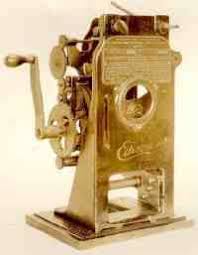 Motion-Picture Camera- Thomas
Edison was an American inventor and businessman. He developed many
devices that greatly influenced life around the world, including the
phonograph, and the motion picture camera. The first motion picture was
of an Edison employee pretending to sneeze. It was a form of
entertainment that enacts a story by sound and a sequence of images
giving the illusion of continuous movement. it was one of the coolest
technology formed.
Motion-Picture Camera- Thomas
Edison was an American inventor and businessman. He developed many
devices that greatly influenced life around the world, including the
phonograph, and the motion picture camera. The first motion picture was
of an Edison employee pretending to sneeze. It was a form of
entertainment that enacts a story by sound and a sequence of images
giving the illusion of continuous movement. it was one of the coolest
technology formed.
 Numeral System- The Numeral System is is a writing system for expressing numbers, that is, a
Numeral System- The Numeral System is is a writing system for expressing numbers, that is, a
mathematical notation for representing numbers of a given set, using digits or other symbols. 2,000 years ago Romans developed a system of counting that is very much like the decimal system of counting that we use today. This counting method involved using math.
Printing Press- Johannes Gutenberg was a German blacksmith, goldsmith, printer, and publisher who introduced printing to Europe. His invention of mechanical movable type printing started the printing revolution and is widely regarded as the most important event of the modern period. This simple machine made book available to the public. This method of printing can be credited not only for a revolution in the production of books, but also for fostering rapid development in the sciences, arts and religion through the transmission of texts.
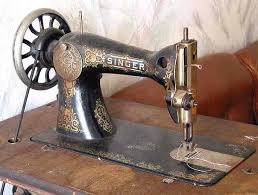
Sewing Machine- Elias Howe was an American inventor and sewing machine pioneer. Howe's machine put out 250 stiches a minute. Before that, stitching was done by hand, and took much longer. Howe finally established his patent rights in 1854, and his invention revolutionized the garment industry. It made it easier and faster to produce goods.

Space race- The space race was a competition between two nations the Soviet Union and the United States for supremacy in space exploration. They used a variety of science, math and technology to make there trip up into outer space. This lead to Neil Armstrong, one of the first two men to land on the Moon, and the first to walk on it, in 1969. And the worlds first artificial satellite, launched in 1957.
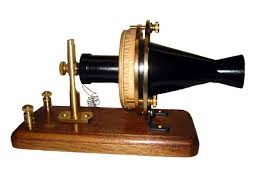 Telephone- Alexander Graham Bell was an eminent scientist, inventor, engineer and innovator who is credited with inventing the first practical telephone. In 1876, at the age of 29, Alexander Graham Bell invented his telephone. It would let people talk at a distance for the first time.
Telephone- Alexander Graham Bell was an eminent scientist, inventor, engineer and innovator who is credited with inventing the first practical telephone. In 1876, at the age of 29, Alexander Graham Bell invented his telephone. It would let people talk at a distance for the first time.
Tractor- Benjamin Holt was an american inventor who patented and manufactured the first practical crawler-type tread tractor. The continuous-type track is used for heavy agricultural and engineering vehicles to spread the weight over a large area to prevent the vehicle from sinking into soft ground. This made it an easier way to garden and travel.

Windshield Wipers- Mary Anderson was an American realestate developer, rancher, viticulturist and inventor of the windshield wiper blade. Anderson patented a rubber blade that would clear windshields in rainy or snowy weather. This was very important because other wise no one would be able to see outside the windows. This was a great invention.
No comments:
Post a Comment